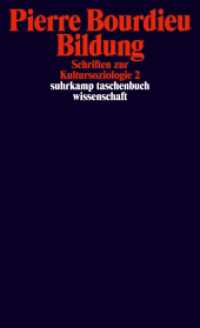- ホーム
- > 洋書
- > 英文書
- > Architecture
基本説明
Uses Migge as a starting point for a comprehensive history of German ecological design, and is the first book in any language to fully document his life and work.
Full Description
Winner of the Elisabeth Blair MacDougall Book Award 2013 presented by the Society of Architectural Historians
Today, contemporary landscape design is increasingly drawing from ideas of sustainability and ecological stability. Not in fact new, the foundations of this approach stem from early twentieth century Germany, where architects and planners were already beginning to use the design concepts which are now referred to as "green".
This ecological school of thought was driven by modernist landscape architect Leberecht Migge (1881-1935). Working with significant modernist architects of the age - including Martin Elsaesser, Ernst May, Bruno Taut, and Martin Wagner - Migge was responsible for some of the most important housing and planning projects of the age; the mass housing settlements, or Großsiedlungen, of Frankfurt Main and Berlin.
Using "biotechnic" principles to integrally link dwelling and garden, Migge was able to recycle household waste to grow foodstuffs through the use of innovative infrastructure and open space planning. Also a skilled park and garden designer, he drew together green and architectural elements in his "garden-architectonic" approach.
David H. Haney's book is the first to fully document Leberecht Migge's life and work. Using Migge as a starting point, Haney addresses conceptual and theoretical aspects of German ecological design, challenging conventional assumptions about modernism and ecological design history. With 200 illustrations and photographs, When Modern Was Green is ideal for students and academics interested in modernism, landscape history and higher level German studies.
Contents
Introduction 1. The Architectonic Garden: c. 1900-1913 2. The Social Garden: c. 1913-1923 3. The Technological Garden: c. 1924-1929 4. The Biological Garden: c. 1930-1935 Conclusion







